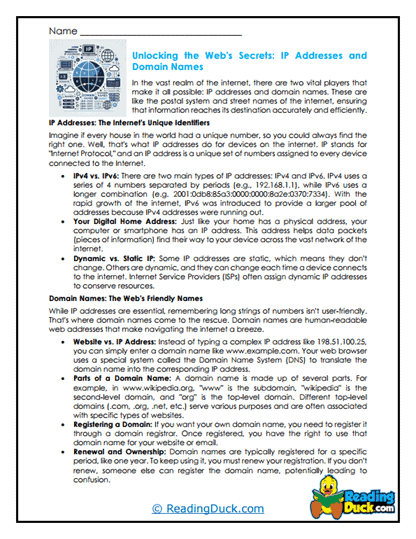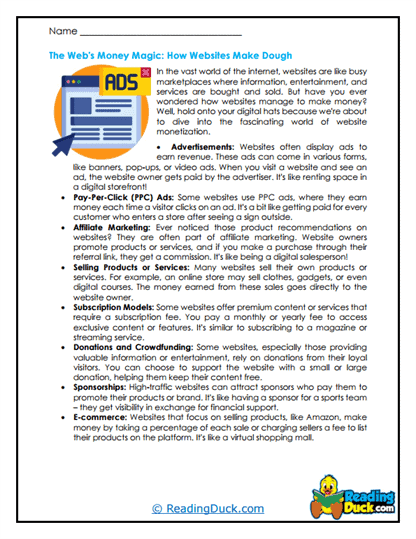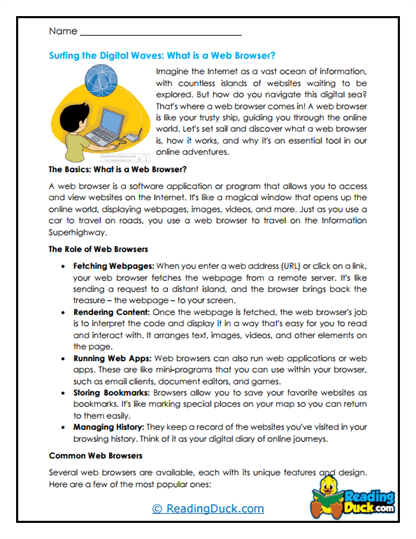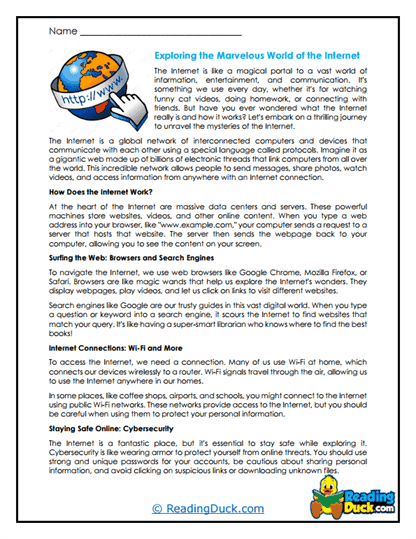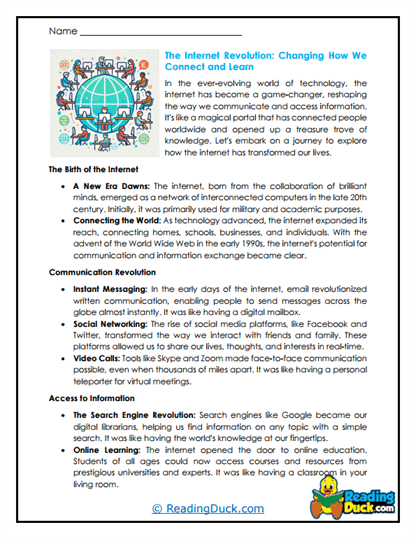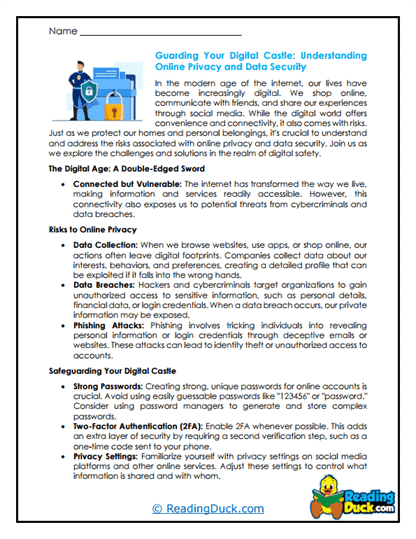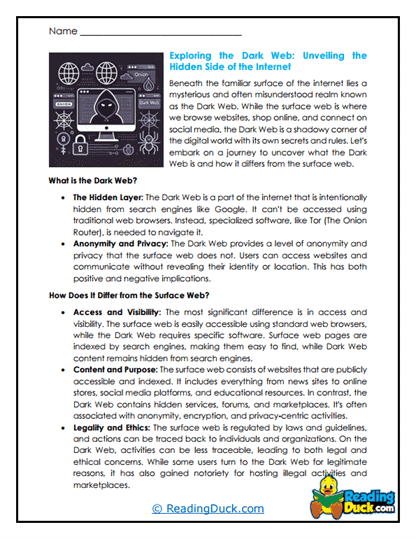The Internet Worksheets
About Our Internet Worksheets
Our Internet Worksheets are designed to help students understand the intricacies of the Internet, a transformative technology that has reshaped every aspect of modern life. The Internet has become an essential tool for communication, information, entertainment, and commerce. These worksheets delve into various facets of the Internet, making complex concepts accessible to students and encouraging them to think critically about the technology they use every day.
In the Technology category, these worksheets sit alongside topics such as 3D Printing, Artificial Intelligence, Autonomous Vehicles, Blockchain and Cryptocurrencies, Cloud Computing, Cybersecurity, Data Analytics, Electric Cars, and Quantum Computing. These topics are selected to cover a broad range of technological innovations, ensuring that every student can find something that piques their interest.
Each Internet worksheet set focuses on a specific aspect of the topic, helping students build a comprehensive understanding:
- Multiple Choice Questions: These questions assess students’ comprehension of the reading passages, ensuring they understand the fundamental concepts about the Internet.
- Short Answer Questions: Students are encouraged to articulate their understanding in their own words, reinforcing their learning and critical thinking skills.
- Open-Ended Questions: These questions invite students to express their opinions, explore their curiosity, and reflect on how the Internet impacts their lives and society as a whole.
Every question sheet is accompanied by an answer key, making it easier for educators to evaluate students' understanding. All worksheets are provided in PDF format, which can be easily accessed, downloaded, and printed for use in various educational settings.
Understanding the Internet: The Backbone of Modern Connectivity
The Internet is a global network of interconnected computers that communicate through standardized protocols. It enables billions of devices to connect and share information, making it the backbone of modern communication and information exchange. The Internet has grown from a small, government-funded project into a vast, complex network that reaches nearly every corner of the globe.
Core Concepts of the Internet:
- Network Structure: The Internet is made up of various networks that are linked together. These networks can range from small local area networks (LANs) to massive wide area networks (WANs) that span continents. Understanding how these networks connect and communicate is essential to grasping the fundamentals of the Internet.
- Internet Protocols: Protocols are the rules that govern how data is transmitted across the Internet. The most important of these are the Internet Protocol (IP) and the Transmission Control Protocol (TCP), which ensure that data is sent and received correctly between devices.
- Domain Name System (DNS): DNS is the system that translates human-friendly domain names like www.example.com into IP addresses that computers use to identify each other. This system is crucial for the functionality of the Internet, allowing users to easily navigate the web.
- Web Browsing and HTTP/HTTPS: The Hypertext Transfer Protocol (HTTP) and its secure version, HTTPS, are the protocols used by web browsers to retrieve web pages from servers. Understanding how these protocols work helps students appreciate the process behind every click on a web link.
- Data Transmission: The Internet relies on various methods of data transmission, including fiber optics, satellite links, and wireless signals. Each method has its own advantages and limitations, influencing the speed and reliability of Internet connections.
Applications and Impact of the Internet
The Internet has a profound impact on nearly every aspect of modern life:
- Communication: The Internet enables instant communication across the globe through email, messaging apps, video conferencing, and social media. This has transformed personal relationships, business practices, and even international diplomacy.
- Information Access: The Internet provides access to an unprecedented amount of information, from academic research to news to entertainment. This has democratized knowledge, making it easier for people to learn new skills and stay informed.
- E-Commerce: Online shopping has revolutionized retail, allowing consumers to buy products from around the world with the click of a button. This has created new opportunities for businesses and entrepreneurs but also introduced challenges related to security and privacy.
- Education: The Internet has transformed education by providing access to online courses, educational resources, and collaborative learning platforms. It has made learning more accessible, flexible, and personalized, catering to a wide range of learning styles and needs.
- Entertainment: The Internet has become a hub for entertainment, from streaming movies and music to playing video games and participating in virtual communities. This has reshaped the entertainment industry and created new forms of media and interaction.
Challenges and Considerations
While the Internet offers numerous benefits, it also presents challenges and risks:
- Privacy and Security: The vast amount of data shared over the Internet raises concerns about privacy and security. Students need to understand the importance of protecting their personal information and the steps they can take to stay safe online.
- Digital Divide: Not everyone has equal access to the Internet, leading to a digital divide that can exacerbate social and economic inequalities. Educators can help students understand the implications of this divide and explore potential solutions.
- Misinformation: The Internet is a powerful tool for information, but it can also spread misinformation and fake news. Teaching students critical thinking and media literacy is essential for helping them navigate the vast amount of content available online.
- Cyberbullying and Online Harassment: The anonymity of the Internet can sometimes lead to harmful behaviors like cyberbullying. Educators should address the ethical use of the Internet and promote a culture of respect and kindness online.
Creative Uses for These Worksheets
To maximize the educational value of the Internet worksheets, teachers and parents can incorporate them into their curriculum in creative and engaging ways:
1. Cross-Disciplinary Projects
- History and Technology: Explore the history of the Internet, from its origins in the ARPANET to its evolution into the World Wide Web. Students can create timelines, write essays, or present research projects on key milestones in the development of the Internet.
- Social Studies: Discuss the societal impact of the Internet, including how it has changed communication, business, and culture. Students can analyze case studies, debate the pros and cons of Internet regulations, or explore the global reach of the Internet.
2. Research and Analysis Assignments
- Have students research current issues related to the Internet, such as net neutrality, cybersecurity, or the role of social media in shaping public opinion. They can present their findings in reports, presentations, or group discussions, fostering a deeper understanding of the complexities of the Internet.
3. Digital Literacy Workshops
- Use the worksheets to teach students about digital literacy, including how to evaluate the credibility of online sources, recognize misinformation, and practice safe online behavior. Students can participate in interactive activities that reinforce these skills, such as fact-checking exercises or creating digital safety guides.
4. Creative Writing and Storytelling
- Encourage students to write short stories or essays imagining life without the Internet or envisioning future innovations in Internet technology. This can help students appreciate the importance of the Internet while fostering creativity and critical thinking.
5. Virtual Field Trips
- Take students on a virtual tour of a data center or an Internet exchange point to see how the Internet operates behind the scenes. This can help students connect the theoretical concepts they’ve learned with real-world applications.
6. Internet Ethics Debates
- Organize debates on ethical issues related to the Internet, such as privacy, censorship, or the role of big tech companies in society. These debates can help students develop their argumentation skills and engage with complex, real-world issues.
7. Interactive Simulations
- Use online simulations or games that demonstrate how data travels across the Internet, how cyber-attacks work, or how digital encryption protects information. These hands-on activities can make abstract concepts more concrete and engaging.
8. Collaborative Group Projects
- Assign group projects where students work together to create websites, blogs, or social media campaigns on a topic of their choice. This not only teaches them about the technical aspects of the Internet but also about teamwork and project management.
9. Guest Speakers and Industry Insights
- Invite guest speakers from the technology industry, such as web developers, cybersecurity experts, or digital marketers, to talk to students about their careers and the importance of the Internet in their work. This can inspire students and provide them with real-world perspectives.
10. Future Exploration
- Encourage students to explore the future of the Internet by researching emerging technologies like the Internet of Things (IoT), 5G, or quantum Internet. They can present their findings through multimedia presentations or creative projects, helping them connect current knowledge to future trends.
By using these Internet worksheets creatively, educators can help students build a comprehensive understanding of the Internet’s role in society and its potential future developments. These worksheets provide a versatile and engaging resource for exploring one of the most important technologies of our time, equipping students with the knowledge and skills they need to navigate the digital world confidently and responsibly.
